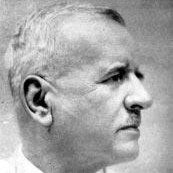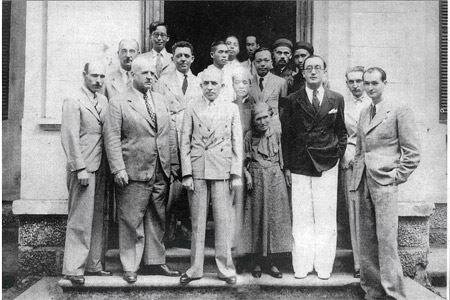Victor Goloubew

Victor Goloubew (Виктор Викторович Голубев, 1878, Saint-Petersburg, Russia — 1945, Hanoi, Vietnam) was a researcher with EFEO for many years, and the first archeologist to extensively use aerial photography to survey Angkor territory in the 1920s.
A son of Russian aristocrats, he studied linguistics, archaeology and art history, partly influenced by his uncle, Alexandr Golubev, a distinguished sinologist. His PHD thesis dealt with Marivaux’s writing. Living in Paris at the turn of the 20th century, he befriended Auguste Rodin, who had recently discovered the art of Royal Ballet of Cambodia. The sculptor made a bust of Goloubew’s wife, Natalia (Nathalie, nicknamed Donatella by d’Annunzio) Cross (26 Aug.1879, Vyborg, Russia, 1 Nov, 1941, Meudon, France). After Natalia left him for the notorious (and quite sulfurous) poet Gabriele d’Annunzio, Goloubew managed to financially help the bohemian singer-translator praised for her beauty, until her death in poverty in 1941. [see an account of d’Annunzio-Natalia’s affair by Jean Despert, 1974]
In his book on the history of EFEO, Pierre Singaravelou wrote:
C’est un personnage de roman, et les Malraux né s’y étaient pas trompés: il s’en sont inspirés pour deux personnages de leurs romans respectifs. Après avoir fréquenté la cour du Tsar dans sa jeunesse, Goloubew épouse dans la capitale de l’Ukraine une très jolie femme, selon les témoignages littéraires de l’époque}. Elle se nomme Nathalie de Cross et c’est la petite fille du professeur E.W. de Pélican, médecin personnel du Tsar Alexandre III. Le couple s’installe à Paris en 1905, vit luxueusement de placements boursiers, fréquente le monde, se lie d’amitié avec Anatole France, Gabriele d’Annunzio, Auguste Rodin. Le sculpteur a fait un bronze de la jeune femme qui quitte Goloubew pour rejoindre d’Annunzio à qui elle a inspiré une oeuvre, Leda Senza Cigno. Nathalie de Cross traduit en francais Forse che si, forse che no et en russe Le martyr de saint Sébastien. Victor Goloubew entre alors en orientalisme; il part pour l’Indochine. [He is a character from a novel, and the Malrauxs were not mistaken: they drew inspiration from him for two characters in their respective novels. After having spent time at the court of the Tsar in his youth, Goloubew has married a very pretty woman in the capital of Ukraine, according to literary accounts of the time. Her name was Nathalie de Cross and she was the granddaughter of Professor E.W. de Pélican, personal physician to Tsar Alexander III. The couple settled in Paris in 1905, lived luxuriously from stock market investments, frequented society, and became friends with Anatole France, Gabriele d’Annunzio, and Auguste Rodin. The sculptor made a bronze of the young woman who left Goloubew to join d’Annunzio, as she has inspired him the poem Leda Senza Cigno. Nathalie de Cross translated Forse che si, forse che no into French and The Martyrdom of Saint Sebastian into Russian. Victor Goloubew then entered orientalism; he left for Indochina.] [p 105]
In 1920, Goloubew went to Angkor with Henri Parmentier and Louis Finot. His research on Banteay Chhmar, Banteay Srei, Banteay Samre, Wat Phou or the Bakheng, made him a leading expert in iconography and archeological photography. Earlier, he had founded in Paris the review Ars Asiatica.
He also studied extensively the ruins of Sambor Prei Kuk and the Kulen Mountain, as well as the sites of the Thanh Hóa Province in Vietnam. A close collaborator of George Cœdès, he was appointed Director of the Louis Finot Museum in 1936. The year before, he was awarded the Herbert Giles Prize by Académie des inscriptions et belles-lettres for his work, particularly his findings in Angkor Thom.
His political involvement with the Axis forces during Second World War II has tainted his reputation as an archeologist and Khmer civilization specialist.
(with leading scholar George Coedès (center) in Phnom Penh)
A 1929 Goloubew portrait autographed to Albert Sallet (Source AAVH)
- Related Books



